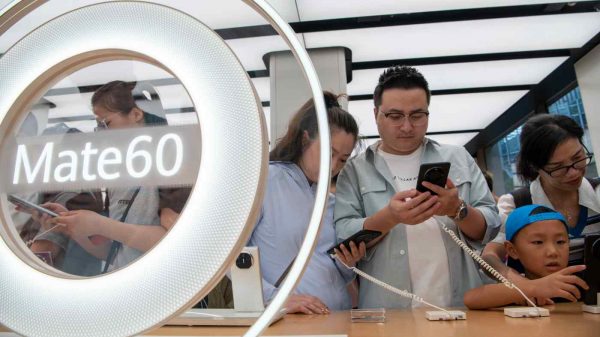Huawei aims to double smartphone shipments to 70m next year

Shawdesh desk:
Huawei has been stockpiling components for months as it aims to double its smartphone sales next year despite expectations of a further U.S. crackdown.
Huawei’s goal is to ship between 60 million and 70 million phones in 2024, two industry executives told Nikkei Asia, doubling shipments compared with this year and last. The company has also been building up its inventory of lenses, cameras, print circuit boards and other parts since earlier this year to meet that goal, multiple supply chain managers and analysts said.
Huawei also asked Qualcomm — its only U.S. supplier of 4G mobile chips — to ship its full-year order by June for fear the U.S. will introduce another round of export controls, two of the people said.
The Chinese tech titan has been under American trade restrictions since 2019 but has not given up on its ambitions for chip development. Its efforts have been helped by the fact that its domestic partners had much of the necessary equipment in place before the U.S. and its allies restricted exports of such technology.
Huawei has worked with China’s top chipmaker Semiconductor Manufacturing International Co. (SMIC) to manufacture 5G mobile chipsets and other advanced chips at its plant in Shanghai, based on 7-nanometer and 14-nm production technology — the country’s most advanced domestic chip production technologies.
China has been the world’s biggest buyer of chipmaking tools since 2020 and has been among the world’s top three chip equipment markets since 2016, according to data from industry association SEMI, and the trend has continued amid increasing political tensions. Its imports of chipmaking tools from Japan, the Netherlands and the U.S. reached $9.24 billion for the first eight months of 2023, and more than $11.4 billion for 2022, China customs data showed. The three countries dominate the global market for advanced chip tools and all three have recently restricted exports of such technology.
“A production line with international tools that are able to develop and produce 7-nanometer chips has been in place as early as 2018 or 2019,” one former employee of American equipment maker Applied Materials said, referring to SMIC’s facility. “This equipment setup bought a meaningful buffer time to alleviate American restrictions and other export controls from Japan and the Netherlands.”
The procurement was made and shipped before the U.S. added SMIC to the Entity List, the former employee said.
SMIC has been developing 14-nm and 7-nm chips for many years, and “it’s not surprising that they finally can have some production,” the person said. Nanometer refers to the distance between transistors on a chip. A smaller number generally indicates a more advanced and powerful chip. For example, Samsung and TSMC are producing 3-nm chips now and already had 7-nm manufacturing capabilities in 2018.
A manager of a Chinese chip equipment supplier familiar with the matter said SMIC’s annual capacity for 7-nm mobile chips could reach 36 million units if quality continues to improve.
Huawei’s aggressive comeback plan could still hit major roadblocks, however, as the U.S. plans to broaden the scope of its already extensive export controls on chipmaking equipment and AI chips. Many U.S. policymakers are urging Washington to withdraw the exemptions and licenses granted to Huawei and Chinese chipmakers such as SMIC.
“Huawei is aiming high in the next two years, and we expect them to move upward on the back of domestic demand cheering on their hometown hero,” Bryan Ma, vice president of device research at IDC, told Nikkei Asia. Ma said Huawei is likely to take some market share from Apple in China’s premium phone segment. But political tensions could throw a wrench in its plans if the company suddenly cannot secure enough components, Ma added.
Huawei’s smartphone business was hit hard by the U.S. crackdown. Shipments went from a peak of 240.6 million units in 2019, when it ranked second in the world, to just 30.5 million units last year, putting it in 10th place, according to market research company IDC.
In response to the crackdown, Huawei began making aggressive moves into chip production, rather than just design, with the help of multiple local governments and emerging chipmakers such as PengXinWei and Shenzhen Pensun Technology (PST), as first reported by Nikkei. It also brought on board Fujian Jinhua Integrated Circuits, which was also blacklisted by the U.S.
Huawei quietly released its Mate 60 Pro in China on Aug. 29. Tech reviews described the device as the company’s first 5G smartphone after the U.S. blacklisting, causing a stir among market watchers and U.S. policymakers. Commerce Department Secretary Gina Raimondo called the development “disturbing” and said new tools were needed to curb China’s tech ambition.
Washington describes Huawei as a national security risk due to its links with the Chinese military, which it constantly denies.
Huawei declined to comment for this story. Qualcomm’s CFO told an earnings conference in August that the company did not expect material revenue from Huawei for the September and December quarters, and said it has a 4G license for shipping to Huawei.
























Leave a Reply